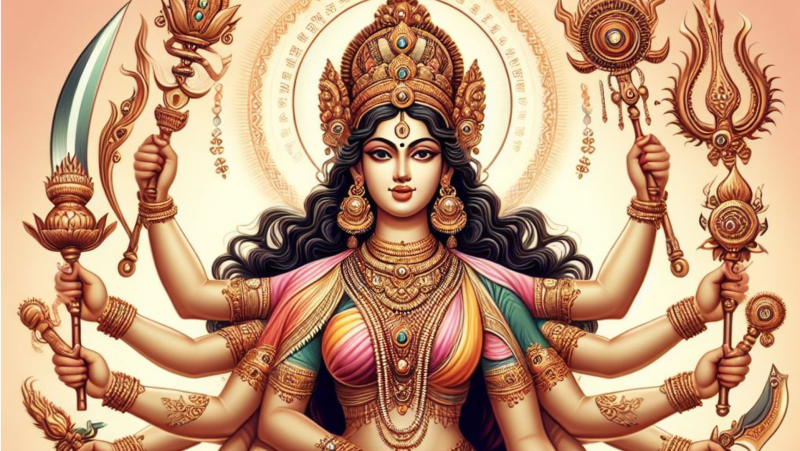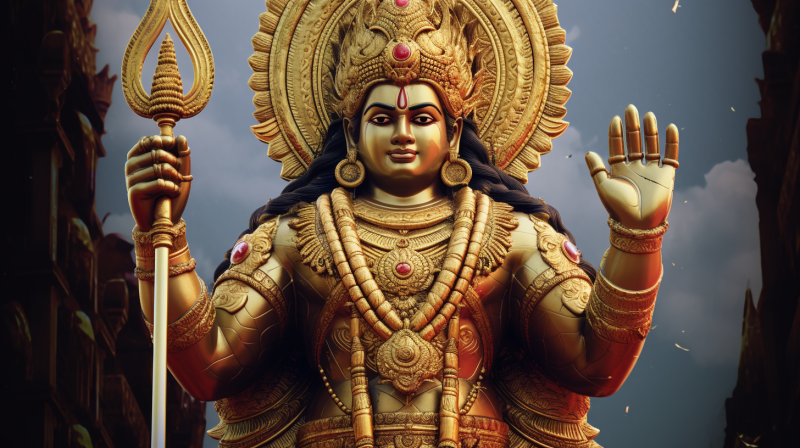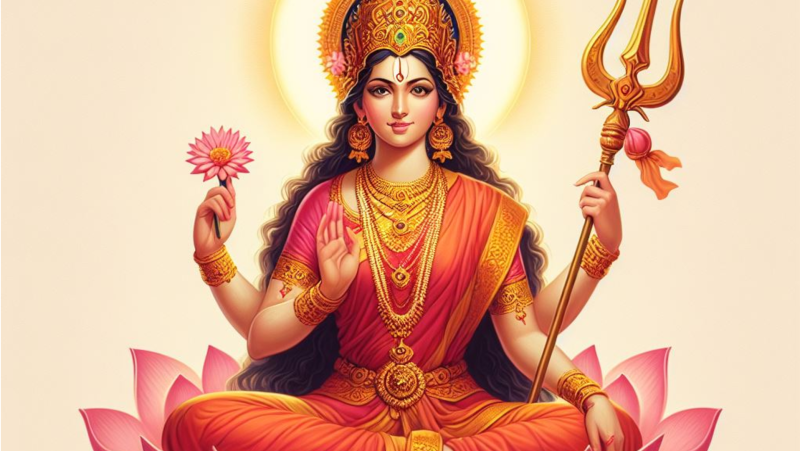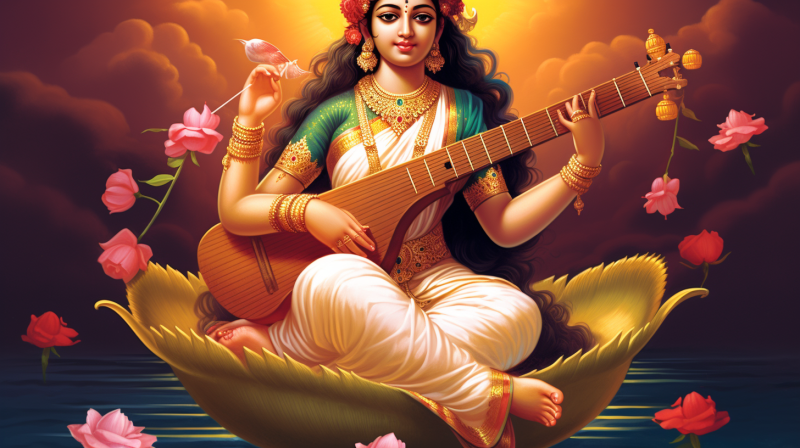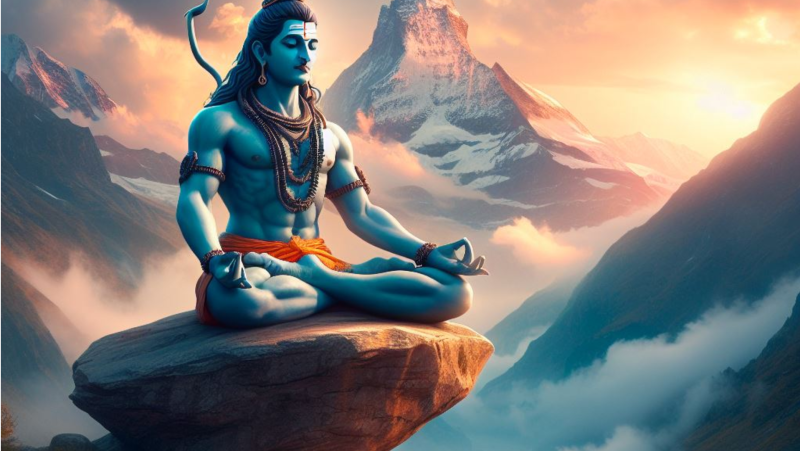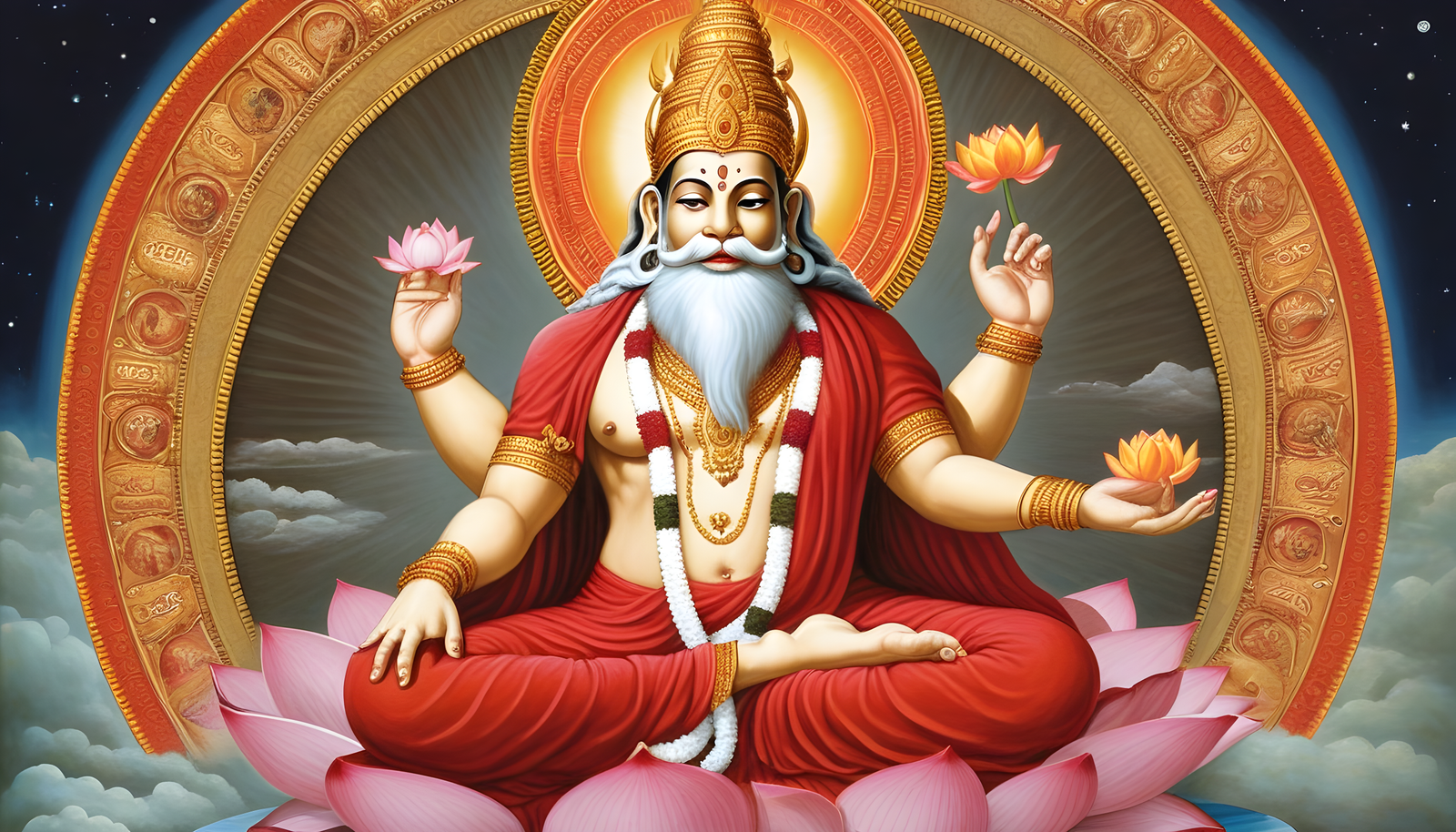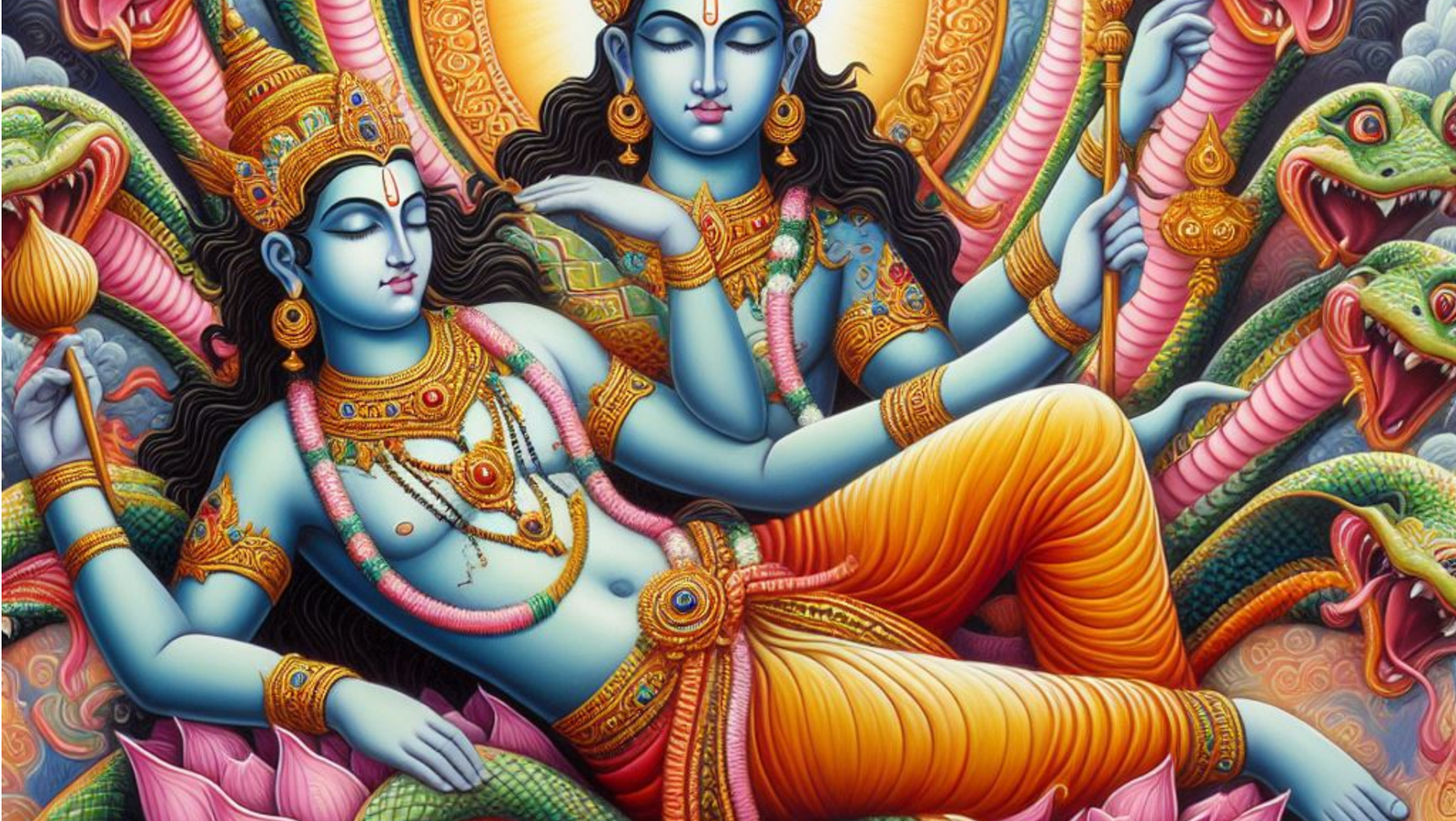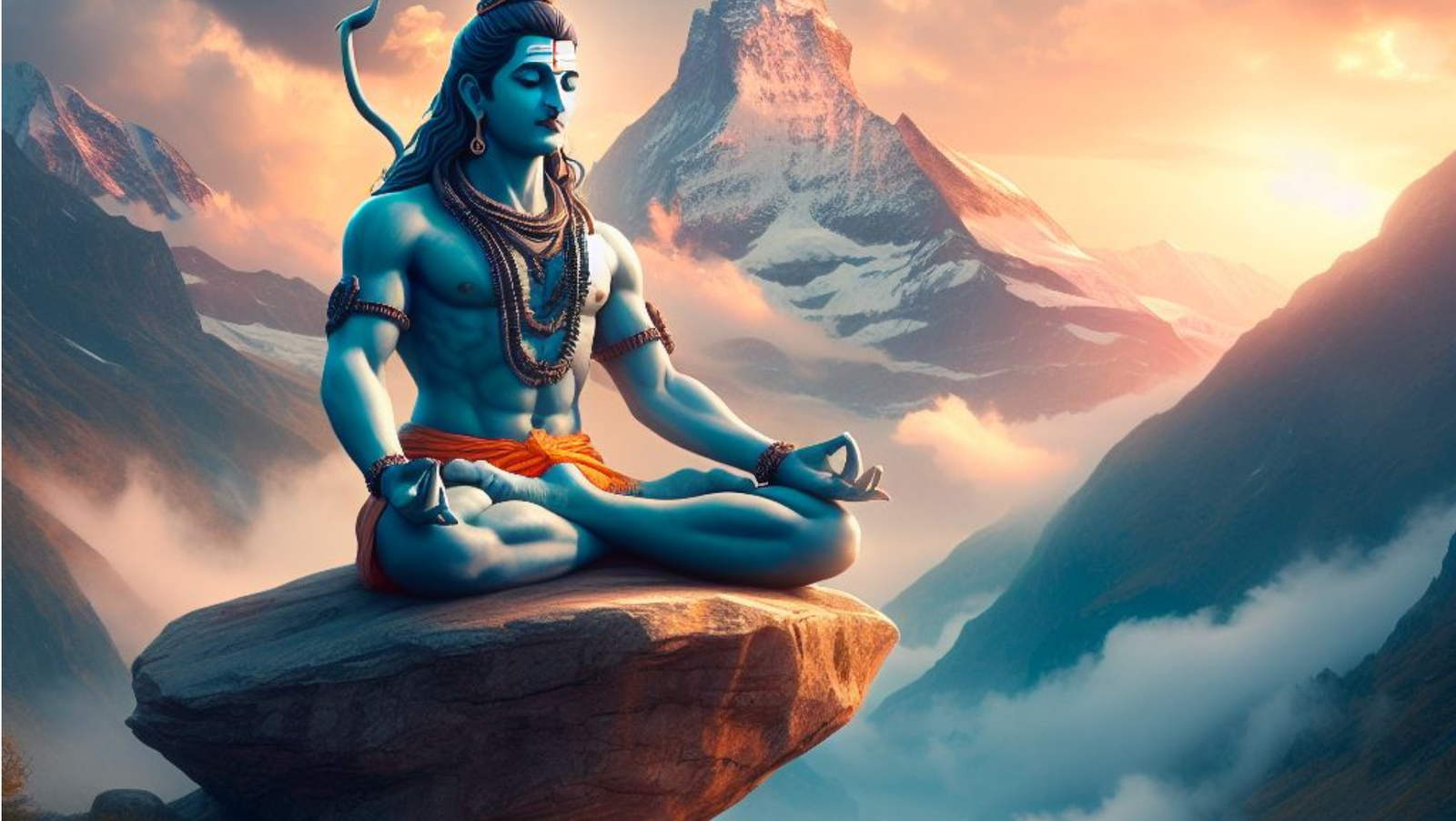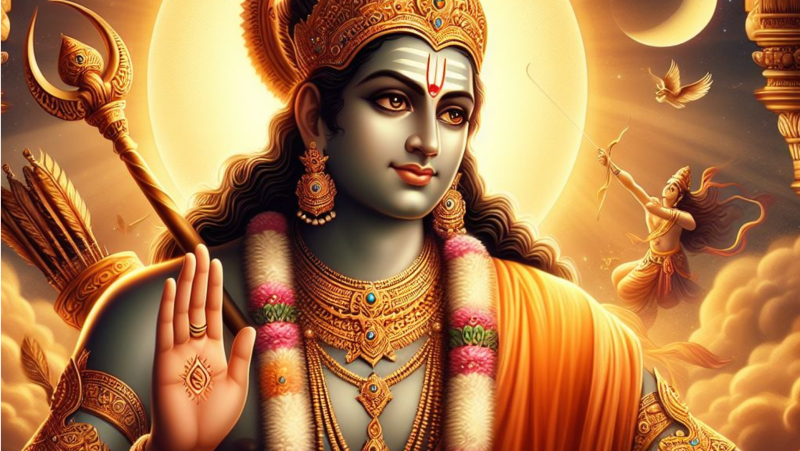
Bhagwan Ram, often simply referred to as Lord Rama, is a revered figure in Hinduism and one of the most significant deities in the religion. He is considered to be the seventh avatar (incarnation) of Lord Vishnu, one of the principal deities in Hinduism responsible for maintaining the order and balance of the universe. The story of Lord Rama is primarily narrated in the ancient Indian epic, the Ramayana, which is attributed to the sage Valmiki.
Birth and Early Life Lord Ram
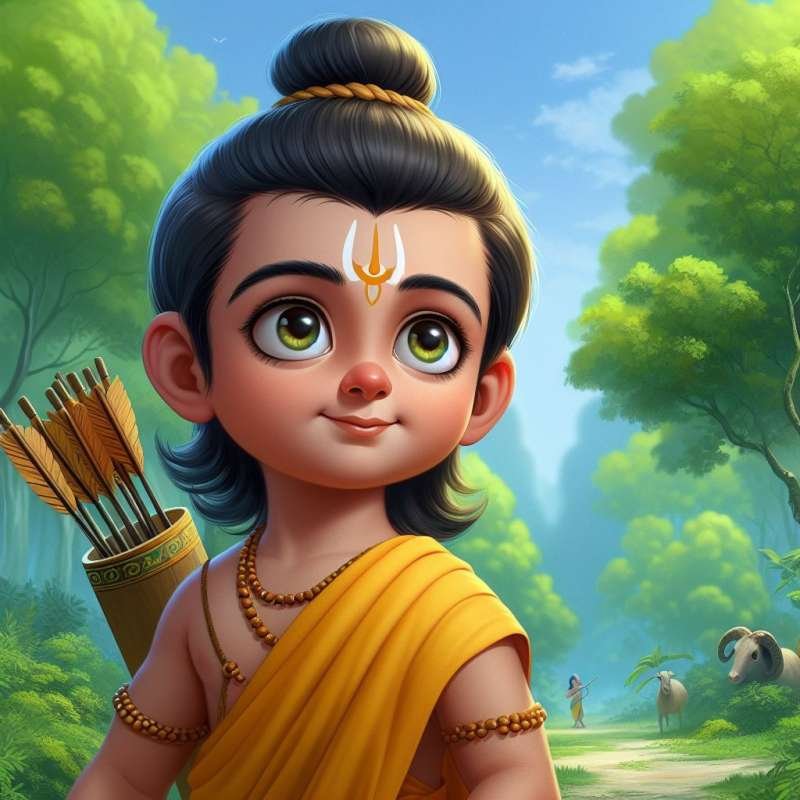
The birth and early life of Lord Rama, also known as Bhagwan Ram, are significant aspects of his life story as narrated in the ancient Indian epic, the Ramayana. His birth is celebrated as one of the most auspicious events in Hindu mythology. Here is a detailed explanation of Lord Rama's birth and early life:
1. Lineage and Background:
• Lord Rama was born in the Ikshvaku dynasty, a prestigious and virtuous royal lineage in ancient India. His father was King Dasharatha, the ruler of Ayodhya, a prosperous city in the northern part of the Indian subcontinent.
• Dasharatha had three wives: Kaushalya, Kaikeyi, and Sumitra. Lord Rama was born to Queen Kaushalya.
2. The Ancestry of Lord Rama:
• According to Hindu tradition, Lord Rama is believed to be the seventh avatar (incarnation) of Lord Vishnu, one of the principal deities in Hinduism responsible for maintaining the order and balance of the universe.
• Lord Rama's birth was foretold in various scriptures and was part of a divine plan to defeat the demon king Ravana and restore dharma (righteousness) on Earth.
3. The Putrakameshti Yagna:
• King Dasharatha and his queens were childless for a long time, which concerned him deeply. To seek the blessings of the gods for progeny, Dasharatha decided to perform a yagna (sacrificial ritual) known as the Putrakameshti Yagna.
• As a result of the yagna, the gods blessed Dasharatha with a divine dessert, which was then distributed to his queens. This led to the birth of four divine sons: Rama, Bharata, Lakshmana, and Shatrughna.
4. Birth of Lord Rama:
• Lord Rama was born on the ninth day (navami) of the Chaitra month (usually in March or April) in the city of Ayodhya. His birth date is celebrated as Rama Navami, an important Hindu festival.
• When Lord Rama was born, the entire kingdom of Ayodhya was filled with joy, and there were celebrations and festivities throughout the city.
5. Early Life and Education:
• Lord Rama's childhood and youth were marked by his exceptional qualities, including his nobility, strength, intelligence, and righteousness.
• He received education and training in various arts, scriptures, and martial skills, becoming proficient in archery and combat.
• He was particularly close to his brothers, especially Lakshmana, and the bond between them was inseparable.
6. Marriage to Sita:
• Lord Rama's marriage to Sita, the daughter of King Janaka of Mithila, is another significant event in his early life. It was a grand and memorable event, marked by the famous bow-breaking ceremony, where only Lord Rama succeeded in stringing and breaking the divine bow of Lord Shiva, earning him the right to marry Sita.
7. Ascension to the Throne:
• While Lord Rama was destined to become the king of Ayodhya, his early years were marked by happiness and prosperity in the kingdom. However, his ascension to the throne would later take a dramatic turn with his exile, which is a central event in the Ramayana.
These early years of Lord Rama's life establish his character as a virtuous, noble, and righteous individual who was not only a prince but also a role model for all, setting the stage for the epic adventures and challenges he would face in his adult life, as described in the Ramayana.
Lord Rama Family
Lord Rama's family, as depicted in the Ramayana, is an important aspect of his life story and is revered in Hindu mythology and tradition. Here's an explanation of Lord Rama's family members:
1. Lord Rama (Rama):
• Lord Rama, the seventh avatar of Lord Vishnu, is the central figure in the Ramayana. He is known for his unwavering devotion to dharma (righteousness) and his embodiment of virtue, compassion, and duty.
• Rama is the eldest son of King Dasharatha and Queen Kaushalya, making him the rightful heir to the throne of Ayodhya.
2. Sita (Sita Devi):
• Sita, also known as Sita Devi or Janaki, is Lord Rama's beloved wife and the incarnation of Goddess Lakshmi, the goddess of wealth and prosperity.
• Sita is renowned for her purity, devotion, and steadfastness. Her unwavering loyalty to Rama is a symbol of ideal wifely devotion (pativrata dharma).
3. Lakshmana:
• Lakshmana is Lord Rama's loyal and devoted younger brother. He is the son of King Dasharatha and Queen Sumitra.
• Lakshmana is known for his unwavering commitment to Rama and Sita. He accompanied Rama into exile and played a crucial role in protecting them during their time in the forest.
4. Bharata:
• Bharata is another younger brother of Lord Rama, born to King Dasharatha and Queen Kaikeyi.
• Bharata is known for his love and devotion to Rama. He was away from Ayodhya when Rama was exiled and, upon learning of the events, he refused to accept the throne in Rama's absence and instead placed Rama's sandals on the royal throne as a symbol of his reign.
5. Shatrughna:
• Shatrughna is the youngest brother of Lord Rama, born to King Dasharatha and Queen Sumitra.
• Shatrughna is known for his loyalty and service to his brothers. He played a supportive role in the events following Lord Rama's exile.
6. Dasharatha:
• King Dasharatha was the ruler of Ayodhya and the father of Lord Rama. He is a key character in the Ramayana.
• Dasharatha's promise to Queen Kaikeyi led to Lord Rama's exile, which serves as a central plot point in the epic.
7. Kaushalya:
• Queen Kaushalya was the chief queen of King Dasharatha and the mother of Lord Rama.
• She played a motherly and protective role in Rama's life.
8. Kaikeyi:
• Queen Kaikeyi was one of King Dasharatha's queens and the mother of Bharata.
• Her demands, driven by the desire for Bharata to become king, led to Lord Rama's exile.
9. Sumitra:
• Queen Sumitra was one of King Dasharatha's queens and the mother of Lakshmana and Shatrughna.
• She is known for her wisdom and devotion to her sons.
Lord Rama's family is a symbol of ideal familial relationships and moral values in Hinduism. His life story, along with the actions and virtues of his family members, serves as a source of inspiration and moral guidance for countless individuals in Hindu culture and philosophy.
The exile of Lord Rama, known as "Vanavas" or "Vanvas,"
The exile of Lord Rama, known as "Vanavas" or "Vanvas," is a pivotal event in the life of Lord Rama as depicted in the ancient Indian epic, the Ramayana. This event marks a significant turning point in the story and plays a crucial role in the overall narrative. Here's a detailed explanation of the exile of Lord
Rama:
1. Background and Context:
• The exile of Lord Rama is primarily the result of a promise made by his father, King Dasharatha, to his wife, Queen Kaikeyi. Kaikeyi had saved Dasharatha's life in a battle and, as a reward, was granted two boons that she could claim at any time.
2. Manthara's Manipulation:
• Manthara, who had a deep-seated animosity towards Lord Rama and Queen Kaushalya (Rama's mother), saw an opportunity to achieve her own goals when she learned about Kaikeyi's two boons. She filled Kaikeyi's mind with doubts and insecurities, suggesting that Rama's presence as king would be a threat to Bharata's future and that he would mistreat her and her son.
3. Kaikeyi's Boons:
• Under the influence of Manthara's poisonous words, Kaikeyi decided to claim her boons to secure the future of her own son, Bharata, and to exile Lord Rama. She asked Dasharatha to place her son, Bharata, on the throne instead of Rama and to send Rama into exile for fourteen years.
4. Dasharatha's Dilemma:
• King Dasharatha was deeply distressed by Kaikeyi's demands, as he loved Rama dearly and had planned to crown him as his successor. However, he was bound by his promise and couldn't refuse Kaikeyi.
• Dasharatha tried to convince Kaikeyi to change her mind, but she remained resolute in her demands.
5. Rama's Acceptance:
• When Lord Rama learned of his father's predicament and Kaikeyi's wishes, he willingly accepted the exile without hesitation. He saw it as his duty (dharma) to uphold his father's word and to respect his mother's wishes, even if they were painful.
6. Sita and Lakshmana's Decision:
• Sita, Rama's wife, and Lakshmana, his loyal brother, also chose to accompany Rama into exile. Sita's decision was a testament to her unwavering devotion and commitment to Rama, while Lakshmana's decision exemplified his loyalty and love for his elder brother.
7. Departure for the Forest:
• On the day of Lord Rama's exile, the entire city of Ayodhya was plunged into sorrow. Lord Rama, Sita, and Lakshmana left the palace and the city in order to begin their fourteen-year-long exile.
• They chose to live in the Dandaka Forest, which was located in the southern parts of India.
8. Life in Exile:
• During their exile, Lord Rama, Sita, and Lakshmana faced various challenges and encounters with demons, sages, and divine beings. The Ramayana chronicles their adventures and the people they met during this period.
• Lord Rama continued to uphold dharma, protect the innocent, and display his exemplary character even in the face of adversity.
The exile of Lord Rama is a central element of the Ramayana and serves as a powerful moral and ethical lesson in Hindu philosophy. It highlights Lord Rama's unwavering commitment to truth, righteousness, and duty, even in the face of personal sacrifice and adversity. This period of exile ultimately sets the stage for the epic battles and events that follow in the narrative of the Ramayana.
Life of Lord Ram, Sita and Lakshan in Exile
The life of Lord Rama, Sita, and Lakshmana during their exile in the forest, as described in the Ramayana, is a central part of the epic's narrative. Their experiences during this period are characterized by various challenges, adventures, and encounters. Here's a detailed explanation of their life in exile:
1. Arrival in the Forest:
• After leaving Ayodhya, Lord Rama, Sita, and Lakshmana entered the Dandaka Forest in central India. They chose to live a simple and ascetic life, upholding the principles of righteousness (dharma) and fulfilling their duties even in the wilderness.
2. Hermitage at Chitrakoot:
• Lord Rama and his companions settled in the Chitrakoot region of the forest, known for its natural beauty and serene surroundings. They built a small hermitage (ashram) where they lived humbly.
• During their time in Chitrakoot, they were visited by sages and hermits who recognized Rama as the embodiment of dharma and offered their blessings.
3. Encounters with Sages and Saints:
• Lord Rama, Sita, and Lakshmana met various sages and saints during their exile. They sought guidance from these wise beings, learning valuable life lessons and spiritual wisdom.
4. Friendship with Sugriva and the Vanara Kingdom:
• As they continued their journey through the forest, Lord Rama and his companions encountered the vanaras (monkey-men), a race of monkey-like beings. Among them, they met Sugriva and Hanuman.
• Lord Rama formed a deep friendship with Sugriva and helped him regain his rightful position as the king of the vanaras, promising to assist him in his quest to find his wife, Ruma.
• This friendship with Sugriva and the vanaras would prove instrumental in Lord Rama's later quest to rescue Sita from the demon king Ravana.
5. Abduction of Sita:
• One of the most crucial events during the exile was the abduction of Sita by Ravana, the demon king of Lanka (modern-day Sri Lanka). Ravana, attracted by Sita's beauty and virtue, tricked her into leaving the protective circle drawn by Lakshmana and abducted her.
Search for Sita by Lord Rama
The search for Sita by Lord Rama after her abduction by Ravana is a significant and central part of the Ramayana epic. This quest demonstrates Rama's unwavering devotion to his wife, his determination to uphold dharma (righteousness), and the assistance he receives from allies.
1. Devastation and Despair:
• After discovering that Sita had been abducted by Ravana, Lord Rama and his loyal brother, Lakshmana, were filled with grief and despair. They realized that Sita's safety and recovery were their top priorities.
2. Meeting with Jatayu:
• While searching for Sita, Rama and Lakshmana encountered Jatayu, a great eagle and friend of Lord Rama's father, King Dasharatha. Jatayu had tried to rescue Sita but was mortally wounded by Ravana. He informed Rama of the abduction and provided valuable information about the direction in which Ravana had taken Sita.
3. Friendship with Sugriva and the Vanaras:
• Continuing their search, Rama and Lakshmana reached the Rishyamukha Mountain, where they encountered Sugriva, the vanara (monkey) king, and his ministers. Lord Rama formed an alliance with Sugriva after helping him regain his kingdom from his treacherous brother, Vali.
• Sugriva, in gratitude, pledged to help Rama find Sita and provided his army of vanaras, including the powerful Hanuman, to assist in the search.
4. Hanuman's Leap to Lanka:
• Hanuman, known for his exceptional strength and devotion to Rama, made a daring leap across the ocean to reach Lanka, where Sita was held captive. He successfully located Sita and conveyed Rama's message to her.
• Hanuman's mission played a crucial role in establishing contact between Rama and Sita and in gathering information about her condition and whereabouts.
5. Building of Rama Setu (Adam's Bridge):
• To reach Lanka and rescue Sita, Lord Rama and the vanara army undertook the monumental task of constructing a bridge (known as Rama Setu or Adam's Bridge) across the ocean. This bridge was built with stones and rocks, and it allowed Rama's forces to cross over to Lanka.
The Battle Between Lord Rama and Ravana
The battle between Lord Rama and Ravana is a central and climactic event in the Ramayana, an ancient Indian epic. This battle, known as the "Ramayana War" or "Rama-Ravana Yuddha," represents the ultimate showdown between good and evil, dharma (righteousness) and adharma (unrighteousness).
Here is a detailed explanation of Lord Rama's battle against Ravana:
1. Confrontation:
• Once in Lanka, Rama's forces confronted Ravana and his demon army. Ravana, known for his formidable powers, engaged in a fierce battle against Lord Rama.
2. Key Events in the Battle:
• The battle between Lord Rama and Ravana was marked by several notable incidents:
• Lord Rama and Ravana engaged in personal combat, displaying their exceptional martial skills.
• Lord Hanuman played a pivotal role by setting fire to Ravana's palace, which further intensified the battle.
• Several powerful warriors from both sides participated, including Ravana's son Indrajit (Meghnad) and Lord Rama's brother Lakshmana.
• Lord Rama's divine arrows, especially the Brahmastra (a powerful weapon), played a significant role in the battle.
3. Defeat of Ravana:
• As the battle raged on, Lord Rama's strength, righteousness, and determination began to prevail. Ravana, despite his prowess, could not withstand the divine power of Lord Rama.
• In the final battle, Rama pierced Ravana's chest with a powerful arrow, ultimately defeating him. Ravana was mortally wounded and lay dying.
4. Ravana's Redemption:
• Before his death, Ravana, realizing his mistakes and the righteousness of Lord Rama, sought forgiveness and enlightenment from Rama. Rama, in his magnanimity, provided Ravana with spiritual guidance and blessed him.
5. Rescue of Sita:
• After Ravana's defeat, Sita was rescued and joyfully reunited with Lord Rama, marking the successful culmination of Rama's mission to rescue his beloved wife.
6. Return to Ayodhya:
• Following the victory over Ravana, Lord Rama, Sita, and Lakshmana returned to Ayodhya, where their return was celebrated with great joy and grandeur. This homecoming is commemorated as Diwali, the festival of lights.
The battle against Ravana is a significant part of the Ramayana, and it serves as a symbol of the triumph of dharma over adharma and the victory of good over evil. It underscores the importance of righteousness, devotion, and the unwavering pursuit of truth and justice in Hindu mythology and philosophy.
Different Names of Lord Ram
Lord Rama, is known by various names and titles that reflect his divine attributes, qualities, and roles in different contexts. Each of these names holds significance and symbolizes different aspects of Lord Rama's character and divinity. Here are some of the prominent names and titles by which Lord Rama is referred to:
1. Rama: This is the most common and widely used name for Lord Rama. It simply means "pleaser of all" and reflects his charming and compassionate nature.
2. Ramachandra: This name means "the moon-like appearance of Rama." It highlights Lord Rama's beauty and radiance, often compared to the moon.
3. Sitarama: This name combines "Sita" (Rama's wife) and "Rama." It symbolizes the inseparable bond between Lord Rama and Sita.
4. Janaki: This name is derived from "Janaka," the name of Sita's father, King Janaka. It is used to refer to Sita as Rama's consort.
5. Dasharathi: This title means "son of Dasharatha." Dasharatha was Lord Rama's father and the king of Ayodhya.
6. Maryada Purushottam: This title signifies Lord Rama as the "ideal" or "perfect" man who always adhered to dharma (righteousness) and moral values. It reflects his impeccable conduct.
7. Purushottama: This title means "the Supreme Person" or "the best among men." It emphasizes Lord Rama's divine nature and his position as an avatar of Lord Vishnu.
8. Raghuveera: This name translates to "the hero of the Raghu dynasty." It emphasizes Lord Rama's heroic qualities and lineage.
9. Kaushalyanandana: This title refers to Lord Rama as the "son of Queen Kaushalya," his mother.
10. Kodandarama: This name highlights Lord Rama's prowess with the bow ("kodanda"), a significant aspect of his life.
11. Dharma Raja: This title means "the king of righteousness" and underscores Lord Rama's adherence to dharma in all circumstances.
12. Raghunatha: This name signifies Lord Rama as the chief of the Raghu dynasty, which includes his ancestors and descendants.
13. Sharavana Bhava: This title is associated with Lord Rama's birthplace, Ayodhya, which is said to have been blessed with Lord Rama's presence.
14. Maryada Parshurama: In some traditions, Lord Rama is also known as Maryada Parshurama, emphasizing his adherence to moral and ethical boundaries.
These names and titles are recited and chanted by devotees in prayers, hymns, and bhajans (devotional songs) as a way to connect with and invoke the blessings of Lord Rama. Each name encapsulates different facets of his divine personality and serves as a source of inspiration and devotion for millions of people in Hinduism.
Appearance of Lord Rama
Lord Rama, the seventh avatar of Lord Vishnu in Hinduism, is described in various ancient texts, including the Ramayana and the Ramacharitamanas, authored by the saint Tulsidas. His appearance is depicted as follows:
1. Human Form: Lord Rama is commonly depicted as a human prince. Unlike some other divine figures in Hinduism who have multiple arms or supernatural forms, Rama is shown with a typical human appearance.
2. Skin Color: Rama is described as having a dark-blue or bluish-black complexion, which is often referred to as "Neelamani" or "Neelarohan" (the one with a blue gem-like appearance). This blue color is believed to symbolize his divine nature.
3. Crown: Rama is often depicted wearing a crown, signifying his royal lineage as the prince of Ayodhya.
4. Attire: He is typically shown wearing royal attire, which includes a dhoti (a long piece of cloth wrapped around the waist), an uttariya (a stole or shawl), and jewelry.
5. Bow and Arrow: Rama is frequently shown holding a bow called the "Kodanda" and a quiver of arrows. The bow symbolizes his warrior prowess, and it is particularly significant because it was with this bow that he broke the divine Shiva Dhanush (bow) during the swayamvara (wedding competition) to win the hand of Sita.
6. Lotus-Eyed: Rama is often described as having lotus-shaped eyes, which are considered attractive and expressive.
7. Sita at His Side: In artistic representations and depictions, Rama is often accompanied by his wife, Sita, who stands by his side. Sita is equally revered in Hinduism and is central to the Ramayana narrative.
8. Bowstring Around His Chest: In some depictions, Rama is shown wearing a bowstring diagonally across his chest as a mark of his warrior identity.
9. Sandals: He is sometimes depicted holding or wearing sandals as a symbol of his journey into exile and his role as a just ruler.
It's important to note that the descriptions of Lord Rama's appearance may vary slightly in different artistic traditions and regions. However, the common theme in all depictions is his princely and regal appearance, which reflects his role as a virtuous and righteous leader, as well as his divine nature as an avatar of Lord Vishnu.
Philosophy and symbolism of Lord Ram
Lord Rama, a central figure in Hindu mythology and religious tradition, holds profound philosophical and symbolic significance. His life story, as depicted in the epic Ramayana, is rich with teachings and symbolism that continue to inspire and guide individuals in various aspects of life. Here are some key philosophical and symbolic aspects of Lord Rama:
1. Dharma (Righteousness): Lord Rama is often regarded as the embodiment of dharma, or righteousness. His unwavering commitment to moral and ethical principles, even in the face of immense challenges and personal sacrifices, serves as a powerful example of how one should uphold dharma in life.
2. Ideal King and Leader: Lord Rama is considered the ideal king (Rajadharma) and leader. His rule in Ayodhya is described as a period of prosperity, justice, and harmony. His leadership qualities, including compassion, fairness, and selflessness, serve as a model for rulers and leaders.
3. Family Values: Lord Rama's devotion to his family, especially his unwavering love and commitment to his wife, Sita, exemplify the importance of family values, fidelity, and the sanctity of marriage in Hindu culture.
4. Detachment and Self-control: Lord Rama's ability to maintain equanimity and detachment in both favorable and adverse circumstances symbolizes the importance of self-control and emotional balance in life.
5. Compassion and Forgiveness: Lord Rama's forgiveness and compassion toward those who wronged him, such as the repentant crow (Shabala), reflect the virtues of forgiveness, humility, and empathy.
6. Duty and Sacrifice: Lord Rama's willingness to sacrifice his own desires and comforts for the sake of fulfilling his duty as a son, husband, and king underscores the importance of duty and selflessness in one's life.
7. Triumph of Good Over Evil: The battle against the demon king Ravana symbolizes the eternal struggle between good (dharma) and evil (adharma). Lord Rama's victory over Ravana represents the triumph of righteousness over unrighteousness.
8. Devotion and Bhakti: Lord Rama's story is often a source of inspiration for devotees practicing bhakti (devotion). His exemplary qualities and divine nature elicit deep devotion and love from his followers.
9. Symbol of Unity: Lord Rama's story transcends religious boundaries and serves as a unifying symbol for people of various backgrounds and beliefs in India. His message of righteousness, harmony, and justice resonates with people of different faiths.
10. Symbol of Ideal Life: Lord Rama's life story serves as a template for leading an ideal life, emphasizing the importance of ethics, morality, duty, and spiritual values.
11. Symbol of Avatar: Lord Rama is recognized as an avatar (incarnation) of Lord Vishnu, who descends to Earth to restore cosmic balance and protect dharma. This underscores the belief in divine intervention and the cyclical nature of existence.
In summary, the philosophy and symbolism of Lord Rama revolve around the principles of dharma, righteousness, selflessness, and moral values. His life story offers valuable lessons and inspiration for individuals seeking to lead a virtuous and meaningful life in accordance with Hindu philosophy and ethics.
You may also like …
Are You The Proud Hindu?
The Trimurti
Create an account to join us and start taking part in conversations.
SIGNIN